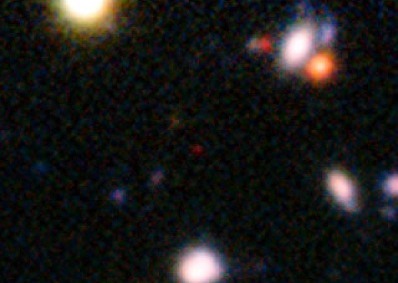
The red speck at the centre of this very deep image from the ESO Very Large Telescope shows the galaxy NTTDF-474, seen when the Universe was only 820 million years old. It is one of the most distant ever to have had its distance measured accurately, and is one of five that have been used to chart the timeline of the reionisation of the Universe about 13 billion years ago. Image: ESO/ L. Pentericci.
There has long been a theory, or perhaps its more of a hypothesis or a conjecture, that the first stars were very different from any class of star we see today. Sci-fi writers and cosmologists wonder if Very Early Massive Objects or VEMO’s might have lit up the early universe and, because of the great density and virtual absence of heavy elements early on, could have had bizarre properties compared to “modern” stars. It’s even possible some may have gone through a phase with nested fusing cores burning multiple substances at the same time, or even semi-distinct cores separated by millions of miles embedded in the same plasma envelope. We may never know just how far off the HR diagram some of these first generation mutants ventured.
But some new findings from the field of cosmology literally shed light on a small part of the puzzle and may reveal, for the first time, what it was that burned away the primeval fog that shrouded the infant cosmos:
“We know that, for stars to be the main contributors, they must be very massive, probably with very low metallicities, and the galaxies they reside in must have very little or no internal dust and gas, to avoid absorbing their light,” explains Fontana. “These features produce a typical spectrum and some of our sources, and in particular those with the highest quality and distance, seem to show this spectral feature, since their spectrum is extremely “blue”, as expected if there is no dust and the stars are metal poor.”
A cosmic fog burned away by intense starlight, that’s pretty cool. Of course whatever these things were, the big ones and medium-sized ones are long gone, only the smallest red and brown dwarfs would remain from that era. Paradoxically, the bigger a star the shorter its life. But that’s the great thing about cosmology, with powerful telescopes and more sensitive detectors we get timescopes. Astronomy enjoys a huge benefit that no other science on earth shares: direct observation of the deep past.

Preview and post is driving me fucking nuts. It keeps reverting to an earlier unedited version. If anything is appearing whacky for you, gentle reader, I apologize.
Pretty powerful imagery; a massive plasma cloud with stellar cores floating through it, like a planetary dust cloud condensing, only stars instead of rocks.
It looks fine to me Stephen, but then the subject matter has me totally in awe, so I may not have noticed.